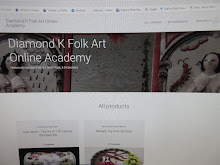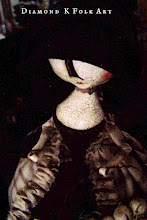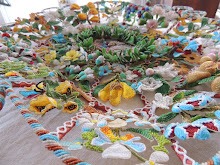1830 Girl's Roller Print Apron 300.2005.11
This week's Museum Monday lucky number is 300! Sized for a toddler, this little apron is just about as precious as one could ever imagine. Aprons were an integral part of the 18th & 19th c wardrobe~ along with pinafores, they helped to keep the gown underneath clean. Such utilitarian pieces of clothing just did not survive~ when Mommy's apron wore out, it was cut down for daughter to wear, or used for household rags and bandages. If it was made from a pretty print or silk, it could have the good sections cut out and used for quilt or pocket patchwork. Indeed, being able to share this rare survivor with you is an absolute joy, for not only is the apron beautifully and artfully contrived, but the shoulder straps are still attached! It's hand stitched from a lightweight border print muslin, with two front pockets and pointed shoulder straps.
Each shoulder strap is made up of a single large triangle. With the orientation of the printed border and corner motifs, along with the small size of the apron as a whole (measure from top of waistband to hem is just 13"), I believe it to be cut from a large kerchief or possibly a head covering, such as a turban. Cloths printed for use as head wraps were very popular in the late teens and twenties. There is a little blush pink silk bow atop each shoulder.
The brown areas of the design have been cylinder printed with blue areas on the seashells either block printed or penciled on by hand.
This week's Museum Monday lucky number is 300! Sized for a toddler, this little apron is just about as precious as one could ever imagine. Aprons were an integral part of the 18th & 19th c wardrobe~ along with pinafores, they helped to keep the gown underneath clean. Such utilitarian pieces of clothing just did not survive~ when Mommy's apron wore out, it was cut down for daughter to wear, or used for household rags and bandages. If it was made from a pretty print or silk, it could have the good sections cut out and used for quilt or pocket patchwork. Indeed, being able to share this rare survivor with you is an absolute joy, for not only is the apron beautifully and artfully contrived, but the shoulder straps are still attached! It's hand stitched from a lightweight border print muslin, with two front pockets and pointed shoulder straps.
Each shoulder strap is made up of a single large triangle. With the orientation of the printed border and corner motifs, along with the small size of the apron as a whole (measure from top of waistband to hem is just 13"), I believe it to be cut from a large kerchief or possibly a head covering, such as a turban. Cloths printed for use as head wraps were very popular in the late teens and twenties. There is a little blush pink silk bow atop each shoulder.
The brown areas of the design have been cylinder printed with blue areas on the seashells either block printed or penciled on by hand.
A precious, wonderful scrap of cylinder, (or roller) printed cotton was used for the outside of the waistband~ its lined in plain muslin and pins closed in the back. This same print also was used for the piping that edges the pockets.
A common problem with fabrics printed using iron mordants is pattern loss such as above~ if you look closely you will see holes where the fabric has totally disintegrated away where the brown has been printed onto the fabric.
A technique known as Broiderie Perse was used to decorate both pockets. It was very popular in the early to mid 19th c for making quilts and coverlets. Motifs were carefully cut from a fancy pattern'd cloth, usually chintz, and then rearranged and appliqued onto a backing.
Perfect tiny and close stitches have kept the edges of the appliques from raveling or lifting. The little girl who once wore this quaint but beautiful apron was surely the envy of all her piers!














1 comment:
Precious and inspiring !
Post a Comment